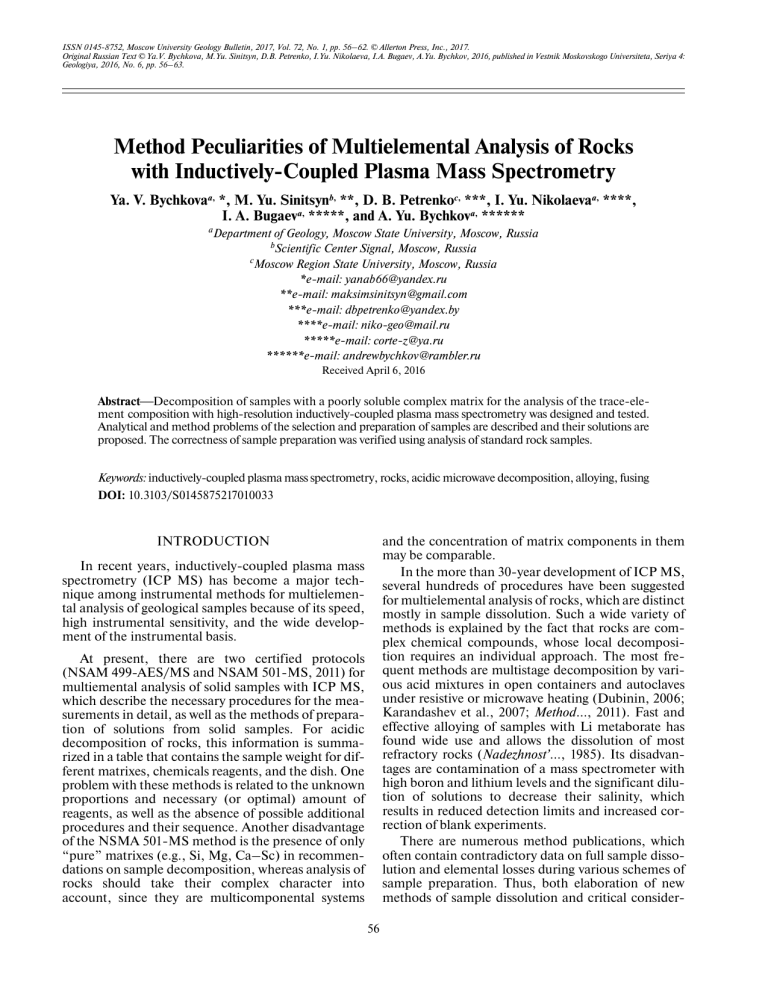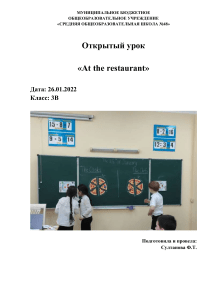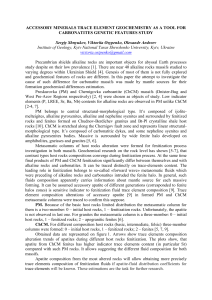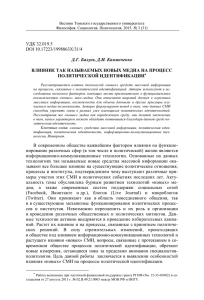Bychkova et al Method peculiarities of multielemental analysis of rocks with inductively-coupled plasma mass spectrometry
advertisement

ISSN 0145-8752, Moscow University Geology Bulletin, 2017, Vol. 72, No. 1, pp. 56–62. © Allerton Press, Inc., 2017. Original Russian Text © Ya.V. Bychkova, M.Yu. Sinitsyn, D.B. Petrenko, I.Yu. Nikolaeva, I.A. Bugaev, A.Yu. Bychkov, 2016, published in Vestnik Moskovskogo Universiteta, Seriya 4: Geologiya, 2016, No. 6, pp. 56–63. Method Peculiarities of Multielemental Analysis of Rocks with Inductively-Coupled Plasma Mass Spectrometry Ya. V. Bychkovaa, *, M. Yu. Sinitsynb, **, D. B. Petrenkoc, ***, I. Yu. Nikolaevaa, ****, I. A. Bugaeva, *****, and A. Yu. Bychkova, ****** aDepartment of Geology, Moscow State University, Moscow, Russia Scientific Center Signal, Moscow, Russia c Moscow Region State University, Moscow, Russia *e-mail: yanab66@yandex.ru **e-mail: maksimsinitsyn@gmail.com ***e-mail: dbpetrenko@yandex.by ****e-mail: niko-geo@mail.ru *****e-mail: corte-z@ya.ru ******e-mail: andrewbychkov@rambler.ru b Received April 6, 2016 Abstract⎯Decomposition of samples with a poorly soluble complex matrix for the analysis of the trace-element composition with high-resolution inductively-coupled plasma mass spectrometry was designed and tested. Analytical and method problems of the selection and preparation of samples are described and their solutions are proposed. The correctness of sample preparation was verified using analysis of standard rock samples. Keywords: inductively-coupled plasma mass spectrometry, rocks, acidic microwave decomposition, alloying, fusing DOI: 10.3103/S0145875217010033 and the concentration of matrix components in them may be comparable. In the more than 30-year development of ICP MS, several hundreds of procedures have been suggested for multielemental analysis of rocks, which are distinct mostly in sample dissolution. Such a wide variety of methods is explained by the fact that rocks are complex chemical compounds, whose local decomposition requires an individual approach. The most frequent methods are multistage decomposition by various acid mixtures in open containers and autoclaves under resistive or microwave heating (Dubinin, 2006; Karandashev et al., 2007; Method…, 2011). Fast and effective alloying of samples with Li metaborate has found wide use and allows the dissolution of most refractory rocks (Nadezhnost’…, 1985). Its disadvantages are contamination of a mass spectrometer with high boron and lithium levels and the significant dilution of solutions to decrease their salinity, which results in reduced detection limits and increased correction of blank experiments. There are numerous method publications, which often contain contradictory data on full sample dissolution and elemental losses during various schemes of sample preparation. Thus, both elaboration of new methods of sample dissolution and critical consider- INTRODUCTION In recent years, inductively-coupled plasma mass spectrometry (ICP MS) has become a major technique among instrumental methods for multielemental analysis of geological samples because of its speed, high instrumental sensitivity, and the wide development of the instrumental basis. At present, there are two certified protocols (NSAM 499-AES/MS and NSAM 501-MS, 2011) for multiemental analysis of solid samples with ICP MS, which describe the necessary procedures for the measurements in detail, as well as the methods of preparation of solutions from solid samples. For acidic decomposition of rocks, this information is summarized in a table that contains the sample weight for different matrixes, chemicals reagents, and the dish. One problem with these methods is related to the unknown proportions and necessary (or optimal) amount of reagents, as well as the absence of possible additional procedures and their sequence. Another disadvantage of the NSMA 501-MS method is the presence of only “pure” matrixes (e.g., Si, Mg, Ca–Sc) in recommendations on sample decomposition, whereas analysis of rocks should take their complex character into account, since they are multicomponental systems 56 METHOD PECULIARITIES OF MULTIELEMENTAL ANALYSIS ation and reasonable combinations of known approaches, which allows analysis of various rocks for a wide spectrum of elements, is topical. SAMPLE PREPARATION Sample preparation is the most laborious procedure; it requires a reasonable approach and accurate operations and results in further correct measurements. It consists of consecutive operations: sampling of the necessary quantity of rock, homogenization, full acid dissolution, and dilution of the solution. Most geological samples are heterogeneous and require specific approaches in sampling and further preparation to maintain their representativeness. The technique of rock sampling for various chemical analyses has been described in detail in many publications. This procedure is very important during geochemical sampling and calculations of the reserves of mineral deposits and has been standardized by GOSTs and OSTs (State Standards) and numerous publications of the previous century. In our opinion, a rather successful book edited by V.I. Rekharskii provides one with methods for the collection of samples and rocks of different compositions and granulometric and mineralogical compositions, as well as statistical data for the sampling methods (Nadezhnost’…, 1985). In our paper, we will briefly recall their basic principles for geologists who sample rocks for ICP MS analysis. This is relevant here because of the low quantity of material for dissolution and further analysis. Typically, the low weight of a sample (60–150 mg) is due to the following reasons: (1) the most effective dissolution of such a quantity with acid and (2) the high sensitivity of ICP MS. Thus, the significant dilution of such small amount of sample for the measurements is needless. Because the solid material represents, as a rule, fragments of rocks (the objects of large size), their dissolution often becomes laborious chemical procedure. In addition, solid substances, as a rule, are heterogeneous and achieving the proportions of their constituents is important for correct analysis of the average content of elements. This is possible only if one takes the ratio between granularity (particle size) and sample volume into account, i.e., the larger the particle size of the sample is, the larger its amount is that is used for homogenization. The material is homogenized during mechanical or manual (in agate or jasper mortar) grinding. The rocks are crushed first. For micro- and small-grained and glassy rocks, the total sample mass can be 0.5 kg. The pegmatoic (giantgrained) rocks, however, require significantly greater sample mass. The standard procedure for crushing and grinding rocks helps to homogenize the sample. To avoid sample contamination by previous materials, the researcher should clean the crushing device, grinder, or mortar during consecutive grinding of a sample series. For the final manual grinding of a samMOSCOW UNIVERSITY GEOLOGY BULLETIN Vol. 72 57 ple, it is recommended to use an agate mortar to avoid the contamination of the sample because of its composition and hardness. The particle size of the final powder should be 30–45 μm, which provides the maximum homogenization of the sample and more qualitative chemical decomposition. PREPARATION OF CHEMICAL REAGENTS AND THE DISH The major problem of sample preparation for multielemental analysis with a high-sensitivity method is the relatively high content of some measured elements in reagents and air and the high “chemical memory” of the dish. Multiple distillations can eliminate the contamination by reagents (water and acid). We used a bottle-to-bottle system in the fluoropolymer (FP PFA) device (Savillex). The system includes two FP bottles, which are connected by a pipe at an angle of 90°. One bottle is filled with especially pure reagent and the system is hermetically connected and mounted vertically along the bend axis below the infrared lamps to achieve an inclination angle of each bottle of ~45° and to heat only the bottle with the primary reagent. Evaporation leads to distillation of the reagent, which is condensed in the bottle–container during cooling. One also can use a device made of quartz glass with acid heating up to a temperature close to boiling; however, quartz glass can saturate the liquid distilled with boron and silicon. As a rule, a single acid distillation is sufficient for multielemental analysis, but requires regular control of blank samples, because the primary reagents are often variously contaminated. The water is distilled twice or deionized, usually using standard devices for distillation (deionization). Depending on the construction, distillers may yield microconcentrations of Fe (in the case of an Fe design), Si, or B (in the case of quartz bottles) to the distilled water. A thermostable glass dish is typically used in classical chemistry for dissolution; unfortunately, glass has a high chemical memory. In addition, low-quality cleaning or random contamination of the dish surface may be the cause of contamination by trace elements. Our experiment showed successful application of FP (Teflon) dish vials and glasses. The choice of the material is caused by several factors. Acid dissolution means the use of a highly active mixture of concentrated acids, evaporation at higher temperature, and movement of the solutions from one type of dish to another. FP is acid- and heat-resistant and allows almost all procedures to occur in the same vial. FP PFA is characterized by low wettability, which allows one to avoid losses of the material during its movement after dissolution. PFA vials can be reusable with careful preparation, which means boiling in nitric acid (32%) and, further, in deionized water resulted in complete removal of traces from previous samples. No. 1 2017 58 BYCHKOVA et al. It is recommended to use disposable plastic vials for the final dilution, which will not be used for the samples intended for trace-element analysis. For reliable purity, the vials are filled with 0.5 N nitric acid, exposed for 1–2 days, and dried in a dessicator. The prepared samples cannot remain in plastic vials for more than 2 months, because long storage may lead to precipitation of some elements from solution on the vial walls. There are several methods of decomposition of solid materials, which can solve various tasks of chemical analysis: (1) acid (multiacid) decomposition, (2) alloying with carbonates, hydroxides or borates of alkali metals with further dissolution of the alloy, and (3) fusing with sodium oxide and further dissolution. Every method has its own advantages and disadvantages and can be used depending on specific tasks. ACID (MULTIACID) DECOMPOSITION As widely applied in modern analytics, this method requires the use of mixtures of concentrated acids, which, under different proportions, allow the achievement of sufficient dissolution of crystal compounds. This method does not allow full decomposition of chromites, topaz, beryl, graphite, and, locally, zircon, as well as measurement of volatiles (B, Se, As, Hg, etc.), because the solutions are evaporated to dry salts. Previously known and widely used decomposition of the matrix by evaporation in a mixture of hydrofluoric and perchloric acids has a series of disadvantages: incomplete decomposition of the material and impossible purification of perchloric acid by distillation. For rocks and minerals, we carried out acid decomposition of silicate samples in a microwave oven. This method is trivial from the point of view of routine dissolution of the material: decomposition of powder in an acid mixture and further evaporation in hydrochloric acid to transform fluorides to chlorides. However, we perfected some details, which are important for ICP MS analysis, in particular, the use of a minimum amount of the dish to avoid sample contamination and its loss during its movement from one reservoir to another. The optimal size of the dish for decomposition and evaporation minimizes the sample loss and increases the amount of samples that is decomposed. The advantages of this method will be described in detail below. Typically, 60–100 mg of powder is sufficient for multielemental analysis of rocks. The sample is placed in a 3–5-mL PFA vial with Savillex covers. A mixture of concentrated hydrofluoric and nitric acids (1.5 cm3, NF : HNO3 = 5 : 1) and HCl (0.5 cm3) are added to vials. Hydrochloric acid is added to increase the stability of noble metals in solution. The vials are carefully covered and evenly placed to the microwave oven. We tested ovens from different producers. Most of them are equipped with Teflon glasses for decomposition (the glass volume is 150 cm3). Heating of an acid mixture in this volume, however, results in spraying the sample on both the glass wall and its cover. The most important problem when using these glasses is the collection of the sample from the walls and the cover to the dish for evaporation. With the advent of a PFA dish with a small volume (we used Savillex vials), a sample is placed into the acid mixture directly to the vial (volume of 3–7 cm3) and several vials are placed into the decomposition glass. Each oven requires the selection of the optimal heating scheme. As a rule, the two-stage regime is most effective: rapid and prolonged heating at highand low-intensity radiation of 400–800 and 50–200 Wt (for 0.5–2.0 and 25–40 min), respectively. The intensity values and time of sample processing depend on the oven construction, the amount of samples, and the degree of complexity of their decomposition. It should be noted that the microwave oven is intended for more qualitative decomposition (because its radiation effectively decomposes the bonds of some compounds) rather than for acceleration of the decomposition process (basalts and granites are decomposed for 2 and 1– 2 days, respectively, in the indicated acid mixture under heating with infrared radiation and even with the mixture in a shaker). The procedure is repeated if the sample was not decomposed and black sediment remained on the vial bottom. The white precipitate is composed of fluorides, which are formed as a result of interaction with HF. These fluorides are transformed to chlorides for full decomposition of the sample. In addition, the measurement occurs with spraying of the sample in the chamber and further ionization in a burner, which are made of quartz glass; the presence of HF traces may lead to consecutive destruction of these devices. The sample is evaporated to dry salt. It is important that solutions are evaporated in the same vials (for decomposition) and require no transfer from one dish to another. The vials can be heated using oven (from the bottom) and infrared (from the top) lamps. In both cases, one important condition exists: the vials with solutions must be isolated from ambient contacts, in particular, with dust and alien particles. For this purpose, we suggest the use of a covered container and pumping of the acid vapors using a water-jet pump. After evaporation to a dry salt, 1 cm3 HCl is added to the vials and evaporation occurs to a dry condition. The procedure is repeated three times for fluoride-to-chloride transfer. If the solution contains a large amount of organic material, 0.5 cm3 of perchloirc acid is added during the second (if necessary, third) evaporation. The dry remnant is combined with 1 cm3 HCl, heated, and transferred to a solution with 0.5 N HNO3 to the 50-mL test tubes (the tube is weighed and is combined with solution from the vial; the vial walls are then carefully cleaned with 0.5 N HNO3, the acid volume is MOSCOW UNIVERSITY GEOLOGY BULLETIN Vol. 72 No. 1 2017 METHOD PECULIARITIES OF MULTIELEMENTAL ANALYSIS increased to 50 cm3, and the tube is weighed again). The test tube can hold a white flaky precipitate, which is dissolved for 3–7 days. To accelerate its dissolution, the test tube is heated in an oven or is placed on a shaker. The precipitate is also effectively dissolved in an ultrasound bath with heating. The solutions that result from decomposition of the solid samples, as a rule, are characterized by excess concentration of matrix elements (macrocomponents that composed the crystal basement of the minerals), which contaminate the solution and affect the degree and intensity of ionization of ions close by ionization energy (Pupyshev and Surikov, 2006; Karandashev et al., 2007). Thus, directly before the measurement the sample is diluted using a weighted method to achieve the concentration of contributing (but not measured) and measured elements of no more than 500 mg/L and 100 μg/L, respectively. In contrast, incorrect measurement of the concentrations of trace elements is possible, as well as damage of the multiplying block of the mass spectrometer. The internal standard is added to every sample with the weight method. Finally, the silicate samples can be diluted for the ICP MS analysis by 40000 to 100000 times, on average. Our experience shows that such a significant dilution provides a long life of the device and allows us, at least partially if not completely, to avoid the influence of elements with high concentrations for trace element ionization (the matrix effect, e.g., with an Al excess in the solution, the intensity of ionization of REEs is suppressed). ANALYSIS OF PLATINUM-GROUP ELEMENTS AND GOLD The determination of contents of platinum group elements (PGEs: Ru, Rh, Pd, Ir, and Pt) and Au requires a specific approach because these elements are present in compounds that are poorly decomposed by the above-described method. In addition, their concentration is too low for the direct measurement from the solution, thus they should be concentrated. Decomposition of the Sample A 1.0–1.5-g sample is placed into a glassy carbon cup, wetted by water, and 15 cm3 of hydrofluoric acid and 15 cm3 of chlorine acid are added. The cup is placed on an electric stove and the sample is heated to 150°C and evaporated to a wet salt. To remove the hydrofluoric acid the sample is treated twice with 15 cm3 of concentrated chlorine acid, each time evaporating it to wet salts. The contents of the cup are combined with 20 cm3 2M HCl and salts are dissolved during heating. The solution is filtered into a 100-cm3 measuring bottle through a Blue ribbon filter that is 9 cm across and the precipitate is washed 3–4 times on the filter by hot 2M MOSCOW UNIVERSITY GEOLOGY BULLETIN Vol. 72 59 HCl and hot water. The filtrate with precipitate is placed into the corundum crucible and ignited in an incinerator at 500 ± 20°C. The residue is carefully mixed with 0.5 g Na peroxide and melted in an incinerator for 20 min at 600°C. The cold alloy is moved to a 100-cm3 glass, combined with 50 cm3 of water, and neutralized with 2M HCl to pH 1 (according to universal indicator paper); 10 cm3 of concentrated HCl is then added. This solution is mixed with filtrate, moved to a 100-cm3 measuring bottle (where the primary filtrate occurred), and adjusted with 2M HCl to the mark. For concentration of PGEs and Au, 30–100 cm3 of sample solution and 2.5 cm3 of a solution of Te(IV) with a concentration of 2 mg/cm3 in 2M HCl is added to a 150-cm3 glass, adjusted to boiling, boiled for 40 min, and 10 cm3 of fresh 10% Sn(II) chloride solution in 6M HCl is added. The solution is heated on an electric stove up to the formation of a well-coagulated black precipitate, which is filtered through fiberglass and washed with 30–40 cm3 of 2M HCl. The precipitate on a filter is dissolved in 10 cm3 of fresh aqua regia and the filter is washed with 10 cm3 of 2M HCl. The filtrate and wash water are gathered into the glass where precipitation occurred, carefully evaporated to ~0.5 cm3, quantitatively moved to the measuring bottle, and diluted with distilled water to 10 cm3. The sample is diluted directly before the measurement so that the contents of noble metals do not exceed 100 μg/dm3; an aliquot of the Lu internal standard is added so that its concentration in the solution was 10 ppb. QUALITY CONTROL OF THE ANALYSIS This procedure is an essential part of any analytical method. Because the highly sensitive ICP MS method is related to the multistage preparation of samples and a rather complex measurement procedure, the following standards are used for the quality control and consideration of possible instrumental errors: (1) standard certified international samples, which, as much as possible, are close in macrocomposition to the measured samples (with similar matrix), which allows us to take the peculiarities of the matrix into account. The correctness and effectiveness of decomposition are controlled using standard samples, e.g., following the recommended rock standards: BHVO-2, BCR-2, BIR-2, and SGD-1a for mafic rocks (basalts), AGV-2 for intermediate rocks (andesites), and SY-2 for alkaline rocks; (2) control (blank) samples to reveal possible contamination of a sample series during chemical preparation; (3) a solution of the internal standard (typically, a solution of In, Re, and 161Dy) to control for the possible drift of the parameters of the device during the No. 1 2017 60 BYCHKOVA et al. Table 1. Measured contents of trace elements in standard rock samples Sample BHVO-2 (basalt) AGV-2 (andesite) Element content analyzed, μg/g (P = 0.95, n = 18) content certified, μg/g content analyzed, μg/g (P = 0.95, n = 14) content certified, μg/g Li Be Sc Ti V Cr Co Ni Cu Zn Ga Rb Sr Y Zr Nb Mo Cs Ba La Ce Pr Nd Sm Eu Gd Tb Dy Ho Er Tm Yb Lu Hf Ta W Pb Th U 4.4 ± 0.3 1 ± 0.04 31 ± 1 16700 ± 500 314 ± 9 283 ± 7 43 ± 1 112 ± 5 125 ± 8 105 ± 2 23 ± 0.7 9.21 ± 0.14 396 ± 7 23 ± 0.8 175 ± 12 17.0 ± 0.6 4 ± 0.3 0.2 ± 0.1 131 ± 1 14.9 ± 0.2 37.5 ± 0.3 5.30 ± 0.06 24.5 ± 0.3 6.02 ± 0.07 2.07 ± 0.03 6.23 ± 0.06 0.94 ± 0.02 5.31 ± 0.07 0.97 ± 0.01 2.54 ± 0.03 0.33 ± 0.01 2 ± 0.03 0.273 ± 0.003 4.63 ± 0.35 1.25 ± 0.08 0.24 ± 0.06 1.6 ± 0.06 1.23 ± 0.02 0.415 ± 0.006 4.8 ± 0.2 1 ± 0.1 32 ± 1 16300 ± 2000 317 ± 11 280 ± 19 45 ± 3 119 ± 7 127 ± 7 103 ± 6 22 ± 2 9.11 ± 0.04 396 ± 1 26 ± 2 172 ± 11 18.1 ± 1 4 ± 0.2 0.1 ± 0.01 131 ± 1 15.2 ± 0.1 37.5 ± 0.2 5.35 ± 0.17 24.5 ± 0.1 6.07 ± 0.01 2.07 ± 0.02 6.24 ± 0.03 0.92 ± 0.03 5.31 ± 0.02 0.98 ± 0.04 2.54 ± 0.01 0.33 ± 0.01 2 ± 0.1 0.274 ± 0.005 4.36 ± 0.14 1.14 ± 0.06 0.21 ± 0.11 1.6 ± 0.3 1.22 ± 0.06 0.403 ± 0.001 11 ± 0.7 2.1 ± 0.1 13 ± 1 6010 ± 150 118 ± 6 15 ± 1.6 145 ± 0.4 18 ± 1.1 50 ± 4.3 86 ± 3 24 ± 4 66.8 ± 1.8 643 ± 14 18 ± 0.7 233 ± 10 13.4 ± 0.6 1.73 ± 0.44 1.0 ± 0.1 1160 ± 30 37.0 ± 1.0 68.7 ± 1.6 8.12 ± 0.14 30.5 ± 0.5 5.48 ± 0.12 1.72 ± 0.07 5.47 ± 0.22 0.68 ± 0.03 3.52 ± 0.08 0.67 ± 0.01 1.86 ± 0.05 0.25 ± 0.01 1.66 ± 0.04 0.246 ± 0.01 5 ± 0.2 0.83 ± 0.04 0.45 ± 0.10 13.0 ± 0.8 5.9 ± 0.5 1.84 ± 0.14 11 ± 1 2.3 ± 0.4 13 ± 1 – 122 ± 4 16 ± 1 16 ± 1 20 ± 1 53 ± 4 86 ± 8 20 ± 1 66.3 ± 0.5 661 ± 6 19 ± 2 230 ± 4 14.5 ± 0.8 – 1.2 ± 0.1 1130 ± 11 37.9 ± 0.04 68.6 ± 0.5 7.84 ± 0.31 30.5 ± 0.1 5.49 ± 0.03 1.53 ± 0.02 4.52 ± 0.05 0.64 ± 0.01 3.47 ± 0.03 0.65 ± 0.03 1.81 ± 0.02 0.26 ± 0.01 1.62 ± 0.02 0.247 ± 0.004 5 ± 0.1 0.87 ± 0.08 – 13.2 ± 0.5 6.1 ± 0.2 1.86 ± 0.09 MOSCOW UNIVERSITY GEOLOGY BULLETIN Vol. 72 Calculated detection limits, μg/g (S/N = 3) 0.07 0.11 0.04 0.1 0.1 0.4 0.1 0.8 1.1 4.9 0.01 0.03 0.1 0.02 0.5 0.1 0.85 0.01 1 0.02 0.01 0.004 0.02 0.01 0.002 0.02 0.003 0.003 0.001 0.003 0.001 0.01 0.001 0.01 0.401 0.018 0.11 0.01 0.003 No. 1 2017 METHOD PECULIARITIES OF MULTIELEMENTAL ANALYSIS 61 Table 2. The results of the analysis of noble metal contents in standard samples Element Ru Rh Pd Ir Pt Au Value, μg/g Analyzed (n = 3; P = 0.95) Certified Analyzed (n = 3; P = 0.95) Certified Analyzed (n = 3; P = 0.95) Certified Analyzed (n = 3; P = 0.95) Certified Analyzed (n = 3; P = 0.95) Certified Analyzed (n = 3; P = 0.95) Certified Sample UMT-1 HO-1 (GSO 1703-86) AMIS 0107 AMIS 0099 0.020 ± 0.006 0.0109 ± 0.0015 0.010 ± 0.002 0.0095 ± 0.0011 0.150 ± 0.010 0.106 ± 0.015 0.007 ± 0.003 0.0088 ± 0.0006 0.112 ± 0.010 0.129 ± 0.005 0.075 ± 0.025 0.050 ± 0.002 0.05 ± 0.02 0.029 ± 0.013 0.09 ± 0.02 0.096 ± 0.013 0.64 ± 0.05 0.84 ± 0.17 0.01 ± 0.004 0.01 ± 0.001 0.38 ± 0.07 0.49 ± 0.09 0.05 ± 0.03 0.07 ± 0.01 0.055 ± 0.010 0.107 ± 0.014 0.041 ± 0.010 0.056 ± 0.010 0.510 ± 0.025 0.460 ± 0.042 0.019 ± 0.004 0.019 ± 0.002 0.88 ± 0.05 0.88 ± 0.08 0.081 ± 0.020 0.093 ± 0.016 0.040 ± 0.010 0.060 ± 0.010 0.024 ± 0.005 0.029 ± 0.004 0.232 ± 0.030 0.231 ± 0.024 0.010 ± 0.004 0.010 ± 0.002 0.57 ± 0.10 0.59 ± 0.07 0.089 ± 0.020 0.089 ± 0.016 measurement (Karandashev et al., 2007; Method…, 2011). The control and standard samples are prepared along with a series of studied samples. The internal standard of ICP MS analysis is not used by all analysts who rely on the stability of highly sensitive devices. However, the authors recommend it use, because even in a series of similar samples one can find samples with anomalous concentrations of elements, which can only be an analytical error. The internal standard is added by the weight method to all measured solutions including calibration series and blank and standard samples so that its concentration will be the same for the entire series of analyzed samples. This procedure is required, since the calibration series is measured first. During the measurement of the entire series of samples, major parameters can vary for various reasons, e.g., a fluctuating speed of the sample supply or variable intensity of the signal depending on the temperature in the room, around the nebulizer chamber, or the sector magnet. These variations can be taken into account if the solutions contain an element with a known concentration, which allows consideration of a variable signal intensity using correction coefficients. STATISTICS AND DISCUSSION To be convinced of a correct analysis, it is necessary to check the composition of the certified standard samples. In a series of sample preparation and following analysis, use of the standard samples, which are similar in macrocomposition to the analyzed one, is recommended. This allows us to make sure that we avoided matrix effects and correctly chose the calibration area for calculation. We conducted multiple analyses of two standard samples of basalt and andesite. The contents of trace elements and recommended MOSCOW UNIVERSITY GEOLOGY BULLETIN Vol. 72 passport values for them are shown in Table 1. The detection limit is calculated according to statistical methods (Murray et al., 2014). Table 2 shows the results of analysis of Au and the PGE content on the basis of our method in standard samples and the recommended passport values for them. It is seen from both tables that our values are quite consistent with those certified for all of the studied samples. The perfection of the current methods allowed the design of the most universal method for sample preparation of rocks of various compositions. The high sensitive ICP MS method requires the use of high-purity reagents, as well as special attention to the purity of the chemical dish for decomposition. The analysis of blank samples showed that the reagents of inadequate purity, as well as the insufficient cleanness and large area of the dish significantly increase the detection limits of elements, while highly sensitive mass spectrometers can determine their lower levels. CONCLUSIONS Thus, the following recommendations can be proposed: the maintenance of a high purity level requires, first, cleaning of reagents (distillation of water and acids) and minimization of the area of the dish for decomposition. The use of a reusable dish, both for storage and measurement of samples is prohibited in our opinion. One can use disposable plastic test tubes for these purposes. Unfortunately, acid microwave decomposition is limited in the amount of sample that can be decomposed simultaneously. Because the samples are decomposed in a microwave oven, the size of the sample is restricted by the number of the containers for decomposition that can be placed in the oven (as a No. 1 2017 62 BYCHKOVA et al. rule, 10–16 positions depending on the type and producer of the oven). Our method is described for the MARS microwave system, which allows the possible use of several vials with samples into a basic container and solves several problems at once. Its use minimizes the number of dishes, because the decomposition and further procedures (including thermal) can be conducted in the same Teflon vial. As a result, no losses of samples occur during manipulations with solution; no possible contamination occurs during transfer as well. In addition, this method increases the amount of simultaneously decomposed samples by 2–3 times (depending on the model and type of the microwave oven). The weight method we applied significantly decreases possible errors, which allows us to take only the error of the balances into account during error calculations and to avoid rather significant errors of the volume of the test tubes, dispenser, and other dishes. This also avoids the regular procedures for checking the volume of the dish. Significant dilution of the solutions for the measurements solves two important tasks: (1) it decreases matrix effects and (2) it maintains the purity of the mass spectrometer for the analysis of the entire range of isotopes with low concentrations. These data show that when combined with this system of sample preparation the ICP MS method for the analysis of solid samples is highly sensitive, reproducible, and free from systematic errors, thus allowing determination of the contents of ultramicrocomponents and elements with significant concentrations. ACKNOWLEDGMENTS This work was supported by the Russian Science Foundation (project no. 15-17-00010). REFERENCES Dubinin, A.V., Geokhimiya redkozemel’nykh elementov v okeane (Geochemistry of Rare Earth Elements in Oceans), Moscow: Nauka, 2006. Karandashev, V.K., Turanov, A.N., Orlova, T.A., et al., An application of inductive-coupled plasma mass-spectrometry for elemental analysis of natural environments, Zavod. Lab., Diagn. Mater., 2007, no. 73, pp. 12–22. Method of quantitative chemical analysis. Determination of impurity elements in samples Be, Mg, Al, Si, Ca, Sc, Ti, V, Cr, Mn, Fe, Co, Ni, Cu, Zn, Ga, As, Se, Sr, Y, Zr, Nb, Mo, Pd, Ag, Cd, In, Sn, Sb, Te, Ba, La and other REE, Hf, Ta, W, Re, Os, Pb, Th, and U, as well as in samples of their oxides and salts using ISP-MS. NSAM no. 501-MS, in Otraslevaya metodika III kategorii tochnosti (Enterprise Technique of the III Category of Accuracy), Moscow: RIS VIMS, 2011. Murray, K.K., Boyd, R.K., Eberlin, M.N., et al., Definitions of terms relating to mass spectrometry (IUPAC Recommendations 2013), Pure Appl. Chem., 2013, vol. 85, no. 7, pp. 1515–1609. Nadezhnost’ analiza gornykh porod (fakty, problemy, resheniya) (Reliability of Analysis of Rocks (Facts, Problems, Solutions)), Rekharskii, V.I, Ed., Moscow: Nauka, 1985. Pupyshev, A.A. and Surikov, V.T., Mass-spektrometriya s induktivno svyazannoi plazmoi. Obrazovanie ionov (Inductive-Coupled Plasma Mass-Spectrometry. Formation of Ions), Yekaterinburg: Ural Branch Ross. Akad. Nauk, 2006. Translated by I. Melekestseva MOSCOW UNIVERSITY GEOLOGY BULLETIN Vol. 72 No. 1 2017






